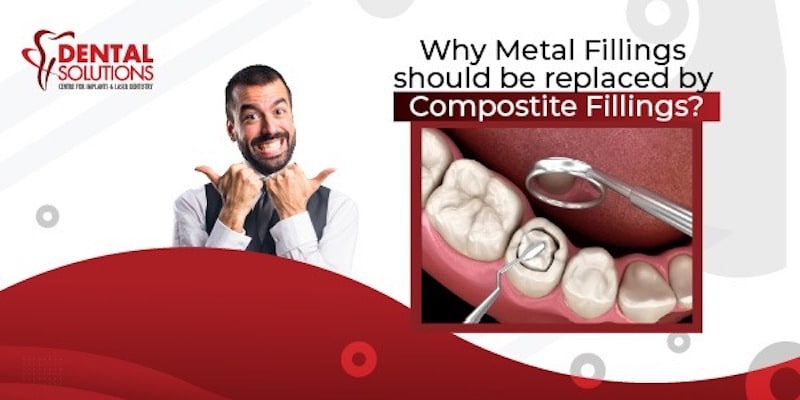Why metal fillings should be replaced with composite fillings

Why metal fillings should be replaced with composite fillings
Metal fillings, also known as amalgam fillings, have been used for decades to repair cavities and other dental issues. However, there are growing concerns surrounding their use. One of the main concerns is the potential health risks associated with metal fillings, including allergic reactions and toxicity. Additionally, metal fillings can expand and contract with temperature changes, potentially leading to tooth cracking and cavity recurrence.
Another concern is the aesthetic appearance of metal fillings, which can be noticeable and unappealing. With the advancement of dental technology, there are now alternative options to metal fillings that are safer and more aesthetically pleasing. In this blog post, we will explore the problems with metal fillings and the benefits of alternative options, such as composite fillings.
In this blog, we will cover the following main points:
- The problems associated with metal fillings, including potential health risks and the potential for tooth cracking and cavity recurrence.
- The benefits of composite fillings as an alternative to metal fillings, including improved aesthetics and better bonding to the tooth structure.
- The procedure for replacing metal fillings with composite fillings, including any preparation required and the steps involved.
- Information on recovery time and post-procedure care for those who have metal fillings replaced with composite fillings.
The Problems with Metal Fillings
Metal fillings, also known as amalgam fillings, have been used for decades to repair cavities and other dental issues. However, there are growing concerns surrounding their use. One of the main concerns is the potential health risks associated with metal fillings, including allergic reactions and toxicity.
Allergic reactions to metal fillings can occur in some individuals, causing symptoms such as itching, rash, and even difficulty breathing. Additionally, metal fillings contain mercury, which is a toxic heavy metal. While the American Dental Association (ADA) states that the levels of mercury in metal fillings are safe, some individuals may be more sensitive to the mercury and may experience negative health effects as a result.
Another concern with metal fillings is that they can expand and contract with temperature changes. This can cause the filling to become loose or even fall out, and it can also lead to tooth cracking and cavity recurrence. This is because metal fillings are not bonded to the tooth structure and do not adapt to changes in the tooth as well as composite fillings. This can cause the tooth to weaken over time, making it more susceptible to future cavities and other issues.
The Benefits of Composite Fillings
Composite fillings, also known as white or tooth-colored fillings, offer several advantages over metal fillings. One of the main advantages is improved aesthetics. Composite fillings are made of a mixture of plastic and fine glass particles that can be matched to the color of the patient’s teeth, making them virtually invisible. This means that composite fillings are a much better option for filling cavities on visible front teeth, as they do not stand out as much as metal fillings.
Another advantage of composite fillings is that they bond directly to the tooth structure. This means that they can be shaped and sculpted to fit the tooth perfectly, creating a tight seal that helps to prevent bacteria from entering the tooth and causing further decay. Additionally, composite fillings can actually strengthen the tooth, as they form a bond that helps to hold the tooth together. This is in contrast to metal fillings, which can weaken the tooth over time as they expand and contract with temperature changes.
Composite fillings are also considered to be a safer alternative to metal fillings. They do not contain mercury and do not pose the same health risks as metal fillings. They also require less tooth structure to be removed during the filling process, which can help to preserve the natural tooth and prevent further damage.
Overall, composite fillings offer several advantages over metal fillings, including improved aesthetics, better bonding to the tooth structure, and the ability to strengthen the tooth rather than weakening it. They are also considered to be a safer alternative to metal fillings.
You may also want to read about the types of dental fillings and their benefits
The Procedure for Replacing Metal Fillings with composites
The process of replacing metal fillings with composite fillings typically involves a few steps and may require one or more visits to the dentist.
- The first step is to have a consultation with the dentist to discuss the reasons for wanting to replace the metal fillings and to determine if composite fillings are the best option for you. The dentist will also examine your teeth to determine the condition of the fillings and the tooth structure.
- Next, the dentist will numb the area around the tooth to be filled with a local anesthetic. The metal filling will then be removed, and the tooth will be cleaned and prepared for the new composite filling.
- The composite filling material is then placed in layers and hardened with a special light. The dentist will then shape and polish the filling to ensure a proper fit and a natural-looking appearance.
The entire process of replacing a metal filling with a composite filling typically takes about an hour. After the procedure, you may experience some sensitivity or discomfort in the treated tooth, but this should subside within a day or two.
Recovery time and post-procedure care
It’s important to avoid eating or drinking hot or cold foods and drinks for the first 24 hours after the procedure to reduce the risk of sensitivity.
It’s also important to maintain good oral hygiene habits, such as brushing and flossing as directed by your dentist and to schedule regular dental check-ups. Your dentist may also recommend that you avoid biting on hard foods or using the tooth for biting until the tooth has fully healed.
Overall, the process of replacing metal fillings with composite fillings is relatively straightforward and can be done in one or more visits to the dentist. Recovery time is usually minimal and any discomfort or sensitivity should subside within a day or two. It’s important to follow the post-procedure care instructions provided by the dentist to ensure proper healing and to maintain good oral hygiene.
Concusion
In summary, metal fillings have been widely used for dental issues, but composite fillings are a better alternative. They are safer, more pleasing to the eye, strengthen the tooth and do not contain mercury. The process of replacing metal fillings with composite fillings is usually done in one or more visits, and recovery time is minimal. If you have metal fillings, it’s worth considering switching to composite fillings, consult with your dentist to determine the best option for you.
References
- “Amalgam (Silver) Fillings” American Dental Association.
- “Composite Resin Fillings” American Dental Association.
- “Mercury Exposure and Children’s Health” World Health Organization.
- “Comparison of marginal adaptation and marginal integrity of composite and amalgam restorations” Journal of Dentistry.
- “Aesthetic Direct Composite Restorations: A Review of the Literature” Journal of Esthetic and Restorative Dentistry.
